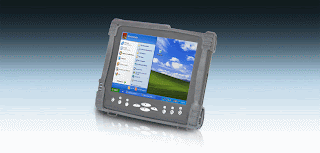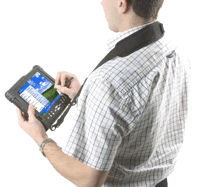Tatung are due to hit the market with what looks like a possible competitor for the Samsung Q1 Ultra.
Available in black or white.
It is affectionately known as the TTAB-T70A and looks pretty good...
Available in black or white.
It has an impressive spec as follows:
CPU VIA C7M @ 1.2GHz
Chipset VIA VX700
Hard Disk 1.8” HDD Options from 30GB or
Compact Flash Based Storage alternatives.
DDR-II Memory 512MB (Options up to 1GB)
Display 7.0” Wide TFT LCD Panel (LED Backlight)
800x480 Resolution
Resistive Touchscreen Input
Video Shared Video Memory up to 128MB
Audio Integral Speakers 2 x 0.5 W
Integral Microphone
Camera Integral 1.3 Mega Pixels
Security AuthenTec Slide type fingerprint sensor (Optional)
Operating System Options: Windows Xpe
Windows XP Pro
Networking Wireless LAN 802.11b/g
Wired LAN 10/100 Mbps (RJ-45 Connector)
Bluetooth v2.0 EDR
Expansion I/O PCMCIA CardBus type II Slot
SD Memory Slot
2 x USB 2.0 Ports
VGA Output (15pin female D-Connector)
Headphone Output Jack
Docking Connector
DC Input Jack
Front Panel Controls 1 x Power Button
4 x Hotkeys
Track Point 1 with Z-Axis Function
Front Panel Indicators 1 x Wireless Status
1 x Power/Charge Status.
1 x HDD Activity
Power Universal AC Adaptor 19V/65W (100~240V)
Rechargeable Li-ion Battery (14.8V@2600 mAh)
Battery runtime up to 4hrs
IP Rating IP53 (Front Bezel only)
Dimensions (W x H x D) 206 x 135 x 31mm
Weight 0.895kg with battery.
Operating Temperature +5°C ~ +35°C
Environmental EMC & Safety CE/FCC
Included Accessories TBC
Optional Accessories Kick Stand (Removable)
Stylus
Docking Station providing:
1 x LAN
3 x USB 2.0 Ports,
1 x Serial
1 x DC-in
CPU VIA C7M @ 1.2GHz
Chipset VIA VX700
Hard Disk 1.8” HDD Options from 30GB or
Compact Flash Based Storage alternatives.
DDR-II Memory 512MB (Options up to 1GB)
Display 7.0” Wide TFT LCD Panel (LED Backlight)
800x480 Resolution
Resistive Touchscreen Input
Video Shared Video Memory up to 128MB
Audio Integral Speakers 2 x 0.5 W
Integral Microphone
Camera Integral 1.3 Mega Pixels
Security AuthenTec Slide type fingerprint sensor (Optional)
Operating System Options: Windows Xpe
Windows XP Pro
Networking Wireless LAN 802.11b/g
Wired LAN 10/100 Mbps (RJ-45 Connector)
Bluetooth v2.0 EDR
Expansion I/O PCMCIA CardBus type II Slot
SD Memory Slot
2 x USB 2.0 Ports
VGA Output (15pin female D-Connector)
Headphone Output Jack
Docking Connector
DC Input Jack
Front Panel Controls 1 x Power Button
4 x Hotkeys
Track Point 1 with Z-Axis Function
Front Panel Indicators 1 x Wireless Status
1 x Power/Charge Status.
1 x HDD Activity
Power Universal AC Adaptor 19V/65W (100~240V)
Rechargeable Li-ion Battery (14.8V@2600 mAh)
Battery runtime up to 4hrs
IP Rating IP53 (Front Bezel only)
Dimensions (W x H x D) 206 x 135 x 31mm
Weight 0.895kg with battery.
Operating Temperature +5°C ~ +35°C
Environmental EMC & Safety CE/FCC
Included Accessories TBC
Optional Accessories Kick Stand (Removable)
Stylus
Docking Station providing:
1 x LAN
3 x USB 2.0 Ports,
1 x Serial
1 x DC-in
My thinking is that this, too, would present similar screen-size problems. However, it may not 'free the teacher' but I think this (and other similar devices) really do represent a glimpse of the future. Might this be the exercise book of 2010? Should we be looking to put devices like these into the hands of children? My feeling is to say 'yes' to both.

































